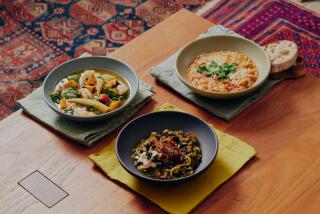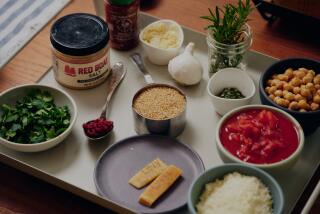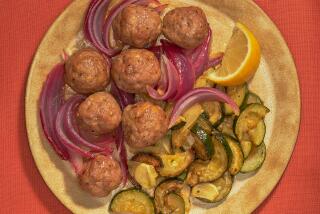The Vinegar Solution
Few people use vinegar, an ingredient common to nearly all kitchen cupboards, except in salad dressings. And their main concern seems to be how to make a dressing that’s not vinegary.
I much prefer the flavor of vinegar to, say, sugar, and I use it in many ways. Vinegar can be a prominent ingredient in a dish, or it can be a secret ingredient that helps other flavors taste more delicious. It can also fix certain cooking mistakes--more than once it has saved my reputation.
Like citrus juice and wine, vinegar is an acidic catalyst for flavor. It lifts certain flavors out of the background and gives them more prominence. Potato soup, for example, benefits from a hint of vinegar to make it more interesting. Use it in combination with a dash of mace; to keep the vinegar discreet, use a mild one such as rice wine or malt.
Vinegar gives backbone to the flavors of a dish by keeping them from disappearing. In certain parts of the country, chili is always served with a cruet of vinegar, because it enhances the tomato flavor, which would otherwise languish beneath the competing tastes. Serve your chili with some good red wine vinegar and see it sparkle.
When cooking with vinegar, always try to muffle its sourness with strong opposite flavors. Salt and vinegar are sensed nearly together on the sides of the tongue, so they can balance each other. Know that a vinegar sauce will need more salt than a wine sauce. Likewise, it is especially helpful to know that the sourness of vinegar can diminish the taste of salt if you’ve added too much to a dish.
Sweet-and-sour combinations--another pairing of opposites--account for some of vinegar’s best uses. Since sweet flavors are sensed on the tip of the tongue, these two sensations--sweet and sour--flicker like a strobe light in your mouth. Sweet pickles, pickle relish and ketchup are all better because of vinegar. And all sweet-savory dishes, such as duck a l’orange , are better when they begin with a gastrique --a caramelizing of vinegar and sugar.
Some of my favorite salad dressing are warm vinaigrettes. Although the vinegar aroma can be almost choking, the effect on the palate is one of mildness and harmony with the oil.
CHICKEN BREASTS XERES
2 (1 1/2-pound) large boneless chicken breasts, split
Salt
Freshly ground pepper
1/2 pound mushrooms
6 tablespoons olive oil
2/3 cup Sherry wine vinegar
2 tablespoons tomato paste
2 tablespoons chopped parsley
Trim excess skin from chicken. Season to taste with salt and pepper. Set aside.
Quarter larger mushrooms, halve smaller ones and set aside.
Heat 1 tablespoon olive oil in nonreactive skillet over high heat and brown chicken, skin-side down. Transfer chicken to plate and pour off fat. Reduce heat to medium. Add vinegar to pan along with tomato paste and mix until blended. Return chicken to skillet, skin-side up. Cover and cook 3 minutes. Remove cover and continue to cook until chicken is done, about 6 minutes more.
Meanwhile heat 1 tablespoon olive oil in another skillet. Add mushrooms and cook 3 to 4 minutes.
Arrange chicken breasts and mushrooms on serving platter. Whisk remaining 4 tablespoons olive oil into pan juices in skillet in which chicken was cooked. Mix in parsley. Pour any juices that may have collected on platter into skillet and whisk until blended. Pour sauce over chicken and mushrooms and serve immediately. Makes 4 servings.
HOT-AND-SOUR SOUP
5 tablespoons unsalted butter or flavorless cooking oil
1 medium onion, coarsely chopped
1/4 cup flour
12 cups chicken stock or canned low-sodium chicken broth
1/2 cup rice wine vinegar
1/3 cup dry Sherry
1 pound boneless, skinless chicken breasts cut into 1/2-inch strips
16 small mushroom caps
1 small onion, finely slivered tip to root
1 tablespoon minced garlic
1 small fennel bulb, finely slivered tip to root, about 1 cup loosely packed
1 teaspoon cayenne pepper plus more, optional
1 teaspoon salt
8 Chinese pea pods, trimmed and slivered lengthwise
4 sprigs watercress, leaves only
Melt 1/4 cup butter in large stock pot over low heat. Add onion and saute gently until tender, 3 to 4 minutes. Sprinkle flour over onion and cook, stirring, 1 minute more.
Add stock, vinegar and Sherry. Increase heat to high and bring mixture to boil. Reduce heat and simmer, uncovered, 1 1/2 hours. Soup should be reduced by half, becoming slightly thick and more intense in flavor. Skim occasionally, as butter and flour particles form scum on top of soup.
Pass soup through fine strainer to remove any lumps of flour and discard along with cooked onions. Soup may be prepared in advance up to this point.
Melt remaining 1 tablespoon butter in 3-quart stock pot over low heat and add chicken, mushrooms, finely slivered onion, garlic and fennel. Cook gently, stirring, 5 minutes. Add soup, cayenne pepper and salt. Increase heat to high and cook, covered, about 5 minutes.
To serve, garnish 4 large soup bowls with uncooked pea pods and watercress. Pour soup into tureen and ladle into garnished bowls at table. Makes 4 servings.
AVOCADO, TOMATO AND SHIITAKE MUSHROOM SALAD
2 hothouse or beefsteak tomatoes or 4 plum tomatoes
2 avocados, cut in halves, seeds removed, peeled
1/3 cup virgin olive oil
12 medium shiitake mushroom caps (if using dried mushroom caps, soak to reconstitute)
1 tablespoon finely minced garlic
1 tablespoon finely minced shallots
1/4 cup red wine vinegar
1/2 teaspoon salt
Freshly ground pepper
Slice tomatoes and avocados from stem to tip and fan out on plates.
Heat olive oil in skillet over medium heat. Add mushrooms and cook, covered, 5 minutes. Add garlic, shallots, vinegar and salt and cook 1 minute more.
Remove mushrooms with slotted spoon and arrange over avocado and tomato slices. Season to taste with pepper. Distribute warm dressing equally over each salad and serve. Makes 4 servings.


